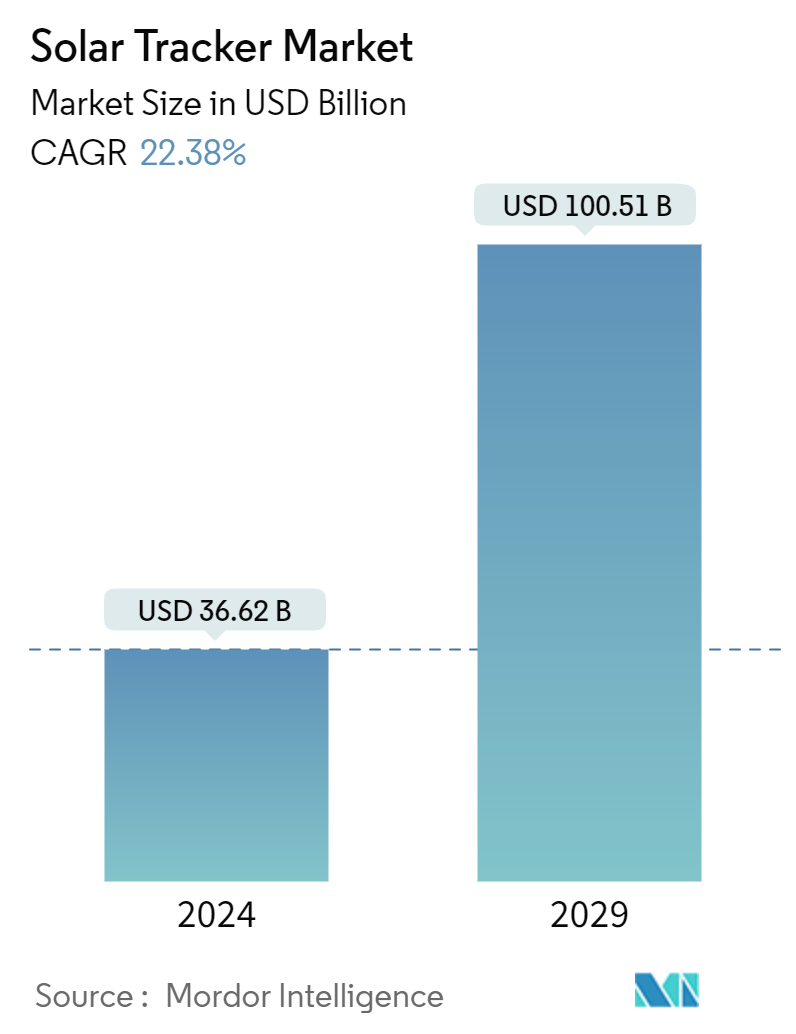Market Size of Solar Tracker Industry

| Study Period | 2019 - 2029 |
| Market Size (2024) | USD 46.15 Billion |
| Market Size (2029) | USD 120.70 Billion |
| CAGR (2024 - 2029) | 21.20 % |
| Fastest Growing Market | Asia-Pacific |
| Largest Market | North America |
| Market Concentration | Medium |
Major Players*Disclaimer: Major Players sorted in no particular order |
Solar Tracker Market Analysis
The Solar Tracker Market size is estimated at USD 36.62 billion in 2024, and is expected to reach USD 100.51 billion by 2029, growing at a CAGR of 22.38% during the forecast period (2024-2029).
- Over the long term, increasing solar PV installations are expected to create demand for solar trackers in the forecast period.
- On the other hand, the high initial investment required to install a tracking system, design complexity, maintenance cost, and limited capacity of solar tracking systems is expected to restrain the usage of solar trackers.
- Nevertheless, factors such as supportive government policies and efforts to meet the increasing power demand using renewable energy sources are expected to create a favorable market for solar panels and for solar trackers in the coming years.
- North America has dominated the solar trackers market, where the United States emerged as a significant customer with solar trackers installed in more than 70% of projects by the end of 2023.
Solar Tracker Industry Segmentation
A solar tracking system maximizes the solar system's electricity production by refocusing the panels to follow the sun throughout the day. It optimizes the angle at which the panels receive solar radiation. Typically, solar trackers are used for ground-mounted solar panels and large free-standing solar installations.
The solar tracker market is segmented by Axis Type and Geography. By axis type, the market is segmented into Single Axis and Dual Axis. The report also covers the market size and forecasts for the market across major regions The report offers the market size and forecasts for solar trackers in revenue (USD) for all the above segments.
| Axis Type | |
| Single Axis | |
| Dual Axis |
| Geography | |||||||||||
| |||||||||||
| |||||||||||
| |||||||||||
| |||||||||||
|
Solar Tracker Market Size Summary
The solar tracker market is poised for significant growth over the forecast period, driven by the increasing installation of solar photovoltaic (PV) systems. Solar trackers, which enhance the efficiency of solar panels by aligning them with the sun's position, are gaining traction due to supportive government policies and the global shift towards renewable energy sources. Despite challenges such as high initial investment costs and maintenance expenses, the market is expected to expand as countries strive to meet rising power demands sustainably. North America, particularly the United States, leads the market, with a substantial portion of solar projects incorporating trackers to boost energy output.
The market landscape is moderately consolidated, with key players like NexTracker Inc., Array Technologies Inc., and Soltec Power Holdings SA playing significant roles. The United States remains a dominant force in the solar tracker market, supported by favorable policies and a strong focus on renewable energy. The preference for single-axis trackers is notable due to their cost-effectiveness and substantial energy yield improvement. While dual-axis trackers offer higher efficiency, their operational and maintenance costs pose challenges. Recent developments, such as the establishment of large-scale manufacturing facilities and strategic agreements for supply, indicate a robust growth trajectory for the solar tracker market, with single-axis systems expected to maintain their dominance.
Solar Tracker Market Size - Table of Contents
-
1. MARKET OVERVIEW
-
1.1 Introduction
-
1.2 Market Size and Demand Forecast in USD, till 2029
-
1.3 Recent Trends and Developments
-
1.4 Government Policies and Regulations
-
1.5 Market Dynamics
-
1.5.1 Drivers
-
1.5.1.1 Increasing Solar PV Installations
-
-
1.5.2 Restraints
-
1.5.2.1 High Initial Investment
-
-
-
1.6 Supply Chain Analysis
-
1.7 Porter's Five Forces Analysis
-
1.7.1 Bargaining Power of Suppliers
-
1.7.2 Bargaining Power of Consumers
-
1.7.3 Threat of New Entrants
-
1.7.4 Threat of Substitute Products and Services
-
1.7.5 Intensity of Competitive Rivalry
-
-
-
2. Market Segmentation
-
2.1 Axis Type
-
2.1.1 Single Axis
-
2.1.2 Dual Axis
-
-
2.2 Geography
-
2.2.1 North America
-
2.2.1.1 United States
-
2.2.1.2 Mexico
-
2.2.1.3 Rest of North America
-
-
2.2.2 Europe
-
2.2.2.1 Germany
-
2.2.2.2 France
-
2.2.2.3 United Kingdom
-
2.2.2.4 Italy
-
2.2.2.5 Spain
-
2.2.2.6 NORDIC
-
2.2.2.7 Turkey
-
2.2.2.8 Russia
-
2.2.2.9 Rest of Europe
-
-
2.2.3 Asia-Pacific
-
2.2.3.1 China
-
2.2.3.2 India
-
2.2.3.3 Japan
-
2.2.3.4 South Korea
-
2.2.3.5 Malaysia
-
2.2.3.6 Thailand
-
2.2.3.7 Indonesia
-
2.2.3.8 Vietnam
-
2.2.3.9 Rest of Asia-Pacific
-
-
2.2.4 Middle-East and Africa
-
2.2.4.1 Saudi Arabia
-
2.2.4.2 United Arab Emirates
-
2.2.4.3 South Africa
-
2.2.4.4 Qatar
-
2.2.4.5 Nigeria
-
2.2.4.6 Egypt
-
2.2.4.7 Rest of Middle East and Africa
-
-
2.2.5 South America
-
2.2.5.1 Brazil
-
2.2.5.2 Colombia
-
2.2.5.3 Chile
-
2.2.5.4 Rest of South America
-
-
-
Solar Tracker Market Size FAQs
How big is the Solar Tracker Market?
The Solar Tracker Market size is expected to reach USD 46.15 billion in 2024 and grow at a CAGR of 21.20% to reach USD 120.70 billion by 2029.
What is the current Solar Tracker Market size?
In 2024, the Solar Tracker Market size is expected to reach USD 46.15 billion.

